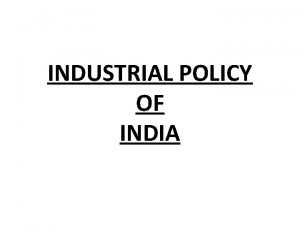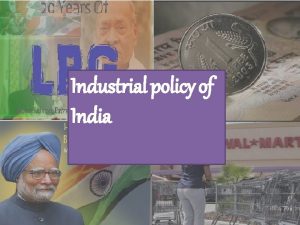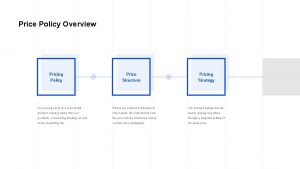AGRICULTURAL PRICE POLICY IN INDIA Agricultural price policy







- Slides: 7

AGRICULTURAL PRICE POLICY IN INDIA

Agricultural price policy is the policy formulated by the Govt. in relation to agricultural prices with the aim of bringing stability in agricultural prices, encouraging agriculturalist to invest in order to increase production, encourage agriculturalist to employ latest technology and making agricultural product avaiable to consumer in adequate quantities and at reasonable prices

Objectives • Stabilization of agricultural prices • Encouragement to farmers to increase production • Protection of the interest of consumer • Self Efficiency: Utilizing the available resources to gain maximum output within the defined time period. • Food Price Stability / Food Security: Stability of food prices with the affordable limits of consumers. The price should reflect the availability of food supplies, and ensure long term availability of nutrition for the population. • Income Distribution: Distribution of the profits of agricultural products to the preferred groups or region.

Main Feature of Agricultural Price Policy in India • Institutions : Agricultural Price commission in 1965 and then renamed Commission for agricultural Costs and Prices • Food Corporation of India started in 1985. n Fixation of MSP: MINIMUM SUPPORT PRICE COST OF PRODUCTION (cost C) INPUT/OUTPUT PRICE PARITY INTER CROP PRICE PARITY EFFECT ON COST OF LIVING PARITY BETWEEN PRICE PAID AND PRICE RECEIVED BY FARMERS (TERMS OF TRADE). n CROPS COVERED UNDER MSP: 23 WHEAT, BARLEY, GRAM, SAFFLOWER RAPESEED/MUSTARD, PADDY, JOWAR, BAZRA, MAIZE, RAGI, PULSES, GROUNDNUT, SOYABEAN, SUNFLOWER, SESAMUM, NIGERSEED, COTTON, TOBACCO, JUTE, SUGARCANE

• Buffer Stock : India’s norms on buffer stocks and strategic reserves require stocking 32 million tonne of food grains.

Effects of Agricultural price policy • • • Increase in Production Change in Cropping Pattern Advantage to farmers Advantage to Consumer Advantage to Industries

Short Comings • • Limited Coverage Less renumerative prices Problems in PDS Inflationary effects












